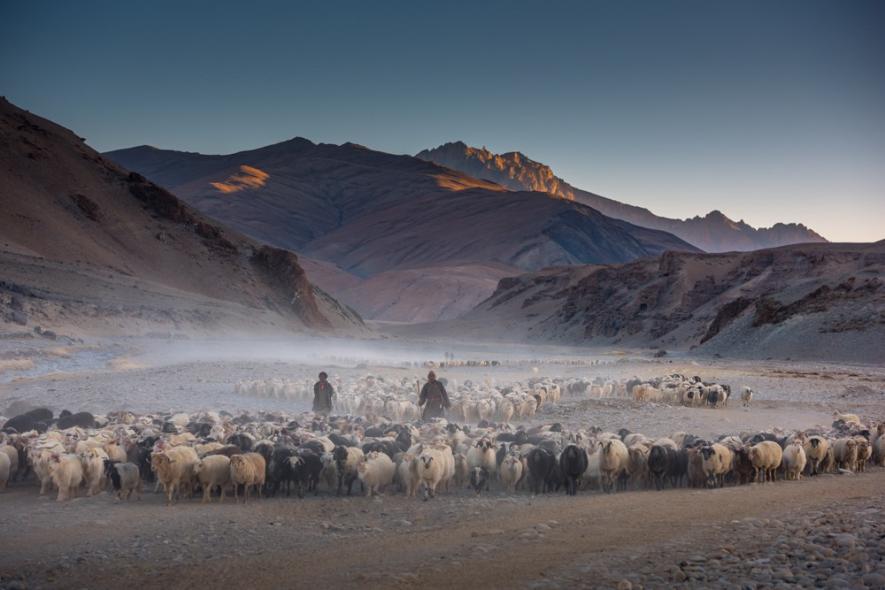Nomadic Pastoralists in Ladakh Face ‘Exodus’ as Indo-China Tension Spikes Along LAC

Srinagar: The escalation on the Indo-China border along the Line of Actual Control (LAC) has led to the exodus of nomadic pastoralists from Ladakh's high altitude areas that served as the grazing land for Pashmina goats—known to be the vital suppliers of world's finest Cashmere wool from the region.
Tension spiked between India and China along the disputed border region of Eastern Ladakh, prompting fears of a possible flare-up between the two nuclear armed countries after deep incursions by Chinese army were reported earlier in May. Since then, both the countries have been locked up in aggressive posturing and experts calling the events along the LAC as an unprecedented escalation in years.
Even as such incursions have happened in the past as well and remained limited to aggressive posturing only, the fresh intrusion by People's Liberation Army (PLA) of China in areas near the picturesque Pangong Tso (lake) and Galwan Valley has renewed fear among the locals of Ladakh. According to them, the fresh chain of events is reminiscent of the Kargil war fought by India-Pakistan in 1999.
"There is a massive troop build-up and it reminds one of Kargil war and what makes the situation difficult is that we are not aware of what's really happening. There is silence on the ground and we are not being informed as to what measures are being taken," Rigzin Spalbar, former Chief Executive Councilor of the Ladakh Autonomous Hill Development Council, told NewsClick.
According to Spalbar, the worst-hit due to the border crisis are the nomadic pastoralists in the region. The nomads, he says, are being pushed back from these forward areas, which is grazing land for their livestock.
"The nomads who live in tents usually in these high altitude areas are moving towards the city and town areas. In this uncertainty, it is becoming difficult for them to survive," Spalbar said.
The Changpas nomads, known for raising yak and goats, supply one of the finest Cashmere wool from Changthangi, a Ladakhi breed of goats also known as Pashmina goats.
LAC watchers have warned of both military and geopolitical ramifications of the conflict between India and China but, for Changpa nomads, the escalation could result in their permanent expulsion from these areas.The fresh incursions were reported from areas in Galwan valley, which acts as the winter grazing land for over 5,000 Changpas if not more, locals say.
"There has been an increase in the mortality among the livestock due to lack of grazing lands; mostly the newborn babies suffer. There are between 70,000 to one lakh Pashmina goats directly affected by loss of the grazing land," Gyurmet Dorji, a councilor from Korzok area—a forward area close to the China border—told NewsClick.
Mostly Buddhists, Changpas also have sheep and yaks in their livestock and are completely dependent on them. As many as eight villages in the forward areas are currently facing the direct ire of the escalation. Apart from livestock rearing, many among them are also dependent on agricultural practices.
The Chinese incursion and subsequent construction activity which has been happening around a disputed area designated as "Finger 4" and locally named Rithar Naga is at the core of the fresh escalation.
The incursions by Chinese Army have disrupted the centuries-old migration system of the Pashmina goats essential for the livelihood of locals. Hundreds of families in Kashmir valley also depend on the supply where it is processed through craft before entering the market.
In a discussion paper, The Changthang Borderlands of Ladakh: A Preliminary Inquiry written by Prof. Sidiq Wahid,a Ladakhi himself, the Indo-China confrontations along the LAC near Changthang has had its own consequences for the settlers, pastoralists and nomadic population living on both sides.
"Specifically, it quickly became apparent that the lack of consideration given by successive governments in New Delhi to the management of spaces and interests of the peoples living on India’s borders is a source of frustration for the local population and, indeed, is rapidly alienating them. There is a need to stem this trend not just for reasons of national security but first and above all for the sake of the people of Ladakh," he wrote.
Even Councilor Gyurmet says he has written to representatives in successive governments about the grazing land dispute and recently in February this year, but lamented lack of any progress.
"For years, I have been bringing the grazing land issue to the notice of authorities, but there is no response in this matter. I wrote one of the first letters in year 2017," Dorji says.
The fresh escalation, locals say, has made them feel "vulnerable", but Muhammad Nasir, BJP councillor from Leh says despite the standoff, the people in capital Leh of the newly created union territory are confident and are seeking a "befitting reply" from the government of India.
"Our army is neck to neck with the Chinese army and this is not 1962. People here are confident and are carrying on with their daily work despite the escalation," Nasir said.
The current Executive Councillor of forward area Chushul, Konchok Stanzin an equivalent of deputy minister, said the troop "build up has been unprecedented". "There is calm as of now but we want things to settle down," Konchok told NewsClick.
Both Saplbar and Dorji echoed Konchok stating that the issue must be addressed once for all before the expulsion of nomads from the region is normalised or becomes permanent.
Also read: Destroying Houses in Kashmir: A Collective Punishment
Get the latest reports & analysis with people's perspective on Protests, movements & deep analytical videos, discussions of the current affairs in your Telegram app. Subscribe to NewsClick's Telegram channel & get Real-Time updates on stories, as they get published on our website.























